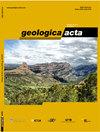板内褶皱和逆冲带的结构:伊比利亚链。A合成
IF 2
4区 地球科学
Q2 GEOLOGY
引用次数: 24
摘要
伊比利亚链是一个复杂的板内褶皱和逆冲带,由欧亚板块、伊比利亚板块和非洲板块在始新世晚期至中新世期间的汇聚而成。其收缩构造的主要走向为NW-SE,但也存在E-W、NE-SW和N-S走向构造。该链及其周围的前陆盆地的边界总是冲断层。北伊比利亚冲断层将该链从Ebro盆地向北分隔开,而Serrania de Cuenca冲断层形成了该链的SE边界,将其与Tajo盆地和La Mancha前陆区分隔开。在这些逆冲断层之间,收缩构造涉及基底,而Serrania de Cuenca逆冲断层以南,只有中生代和新生代岩石参与逆冲系统,在蒸发的三叠纪物质中分离。考虑到链的主要结构,可以区分两个部分。西部和中部地区有两个主要的背斜,由Almazan Synclinorium分隔。Teruel凹陷东部以北东西走向的N向逆冲、中部和南部北西-东南走向的S向逆冲为主导构造。地壳在新生代收缩期间增厚,平均地壳增厚约5km。从横截面获得的水平缩短为32km,从57.5km的密度重力截面获得的。这两个值可以被视为最终值。伊比利亚链的起伏与收缩结构和增厚的地壳有着强烈的区域一致性,表明它们在基因上有亲缘关系。本文章由计算机程序翻译,如有差异,请以英文原文为准。
Structure of an intraplate fold-and-thrust belt: The Iberian Chain. A synthesis
The Iberian Chain is a complex intraplate fold-and-thrust belt resulting from the convergence between the Eurasian, Iberian and African plates during the late Eocene to the Miocene. The main trend of its contractional structures is NW-SE, but E-W, NE-SW and N-S-trending structures are also present. The boundaries of the chain with its surrounding foreland basins are always thrusts. The North-Iberian Thrust separates the chain from the Ebro Basin to the North, while the Serrania de Cuenca Thrust makes the SE boundary of the chain, separating it from the Tajo Basin and La Mancha foreland areas. Between these thrusts, the contractional structure is basement-involved, while South of the Serrania de Cuenca Thrust only Mesozoic and Cenozoic rocks are involved in the thrust-system, detached in the evaporitic Triassic materials. Two parts can be differentiated considering the major structure of the chain. The western and central areas hold two major anticlinoriums separated by the Almazan Synclinorium. East of the Teruel Depression, E-Wstriking N-verging thrusts in the North, and NW-SE-striking S-verging thrusts in the center and South are the dominant structures. The crust thickened during the Cenozoic contraction generating a mean crustal thickening of about 5km. The horizontal shortening obtained from cross-sections is 32km, and from a density-gravity section of 57.5km. These two values may be considered end values. The relief of the Iberian Chain has a strong areal coincidence with the contractional structures and the thickened crust, indicating that they are genetically related.
求助全文
通过发布文献求助,成功后即可免费获取论文全文。
去求助
来源期刊

Geologica Acta
地学-地质学
CiteScore
2.50
自引率
6.70%
发文量
13
审稿时长
>12 weeks
期刊介绍:
- Relevant conceptual developments in any area of the Earth Sciences.
- Studies presenting regional synthesis.
- Thematic issues or monographic volumes presenting the results from one or more research groups.
- Short papers reflecting interesting results or works in progress.
- Contributions and results from Research Projects, Workshops, Symposiums, Congresses and any relevant scientific activity related to Earth Sciences.
- Geologica Acta aims to stimulate rapid diffusion of results and efficient exchange of ideas between the widespread communities of Earth Science researchers (with special emphasis on Latinamerica, the Caribbean, Europe, the Mediterranean
 求助内容:
求助内容: 应助结果提醒方式:
应助结果提醒方式:


